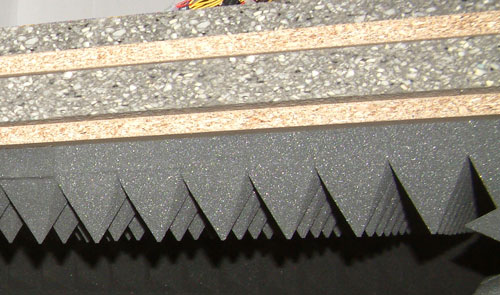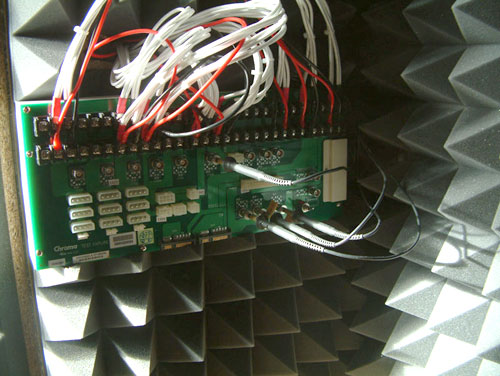Thermaltake TR2 QFan Series
by Christoph Katzer on November 19, 2008 3:00 AM EST- Posted in
- Cases/Cooling/PSUs
Testing with the Chroma ATE Programmable Load

Our test equipment consists of two Chroma programmable DC Loads that enable us to test power supplies with an output of up to 1500W. The biggest advantage of the Chroma DC Loads is simply the high precision it provides. It can measure differences as small as 0.001V and 0.0001A, which will provide us with best-in-class results.
When programming the Chroma with specific amounts of load calculated according to the ATX norm, we are able to load power supplies to an exact percentage. We can now show results at every specific percentage needed. To get the best overview of a power supply, we load each unit with 10%, 20%, 50%, 80%, 100%, and 110% of the specified output. This is easy to calculate for a 1000W power supply: the 10% load is 100W and 110% load is 1100W. Remember that this is the amount of power the PSU delivers; due to inefficiencies, a power supply will actually draw more power from the wall.
Note: If you would like to know more about our testing methodology, equipment, and environment, please read our PSU testing overview.
We have added an additional 10% on the highest load to see how the units perform with overload. This test will be performed in all future reviews. The overload test is performed at room temperature as well as under more stressful conditions; to ensure we are not too cruel to the power supplies, we will keep the ambient temperature at 50°C in the stress test. Experience shows that many units can stand the overload at room temperature but will experience problems with higher temperature and overload together. Only the best-built units will survive this.

The Testing Environment
There is one flaw in testing power supplies with programmable loads while trying to measure the sound pressure levels at the same time. Because the programmable loads get very loud, there is no chance of hearing the power supply on the test stand. In order to make accurate measurements of the noise levels we needed a way to separate the test unit and the programmable loads. Our solution was to build a very thick box around the unit.

We concluded that a five-layer box with a total thickness of 6" (15cm) containing two layers of wood and three layers of special foam would suffice. It is designed as a box within a box. The inner box does not touch any part of the outer box, making it difficult for acoustic noise to pass through in the form of vibration. Each box is isolated on both sides with a layer of heavy foam that is normally used to insulate engines. On the inside we have an additional layer of 4" (10cm) thick pyramidal foam on every side of the box to eliminate the acoustic waves coming from the test object as well as we can.

To ensure a completely closed system we installed the printed circuit board that the connectors of the power supply are attached to inside the anechoic room/box. In other box designs, you would need to put all the cables through the wall. Unfortunately, that would result in the inside of the box not being fully isolated anymore. Our design keeps everything that needs to be connected inside of the box and maintains isolation.










36 Comments
View All Comments
strikeback03 - Wednesday, November 19, 2008 - link
Do all the fans follow that exact curve? Or does the 300W hit 30+dB near max output?Also, don't tip vortices flow off the tips of blades? Making a fan unlikely to suck air in from open sides?
cweinheimer - Wednesday, November 19, 2008 - link
Please include the thermaltake tr2 430 watt unit for midrange budget psu comparison. In the 400-500 watt category on newegg, it appears to be the highest selling unit with 1946 reviews, and highest rating. I have a few and have been happy with them for midrange game rigs.7Enigma - Wednesday, November 19, 2008 - link
Apparently I'll be the first post so let me say for many of us readers THANK YOU. I/we have been waiting for a review like this for the 90% of us that will benefit from these lower power supplies. I will be building a mid-range (single gpu, moderately OC'd quad) in the next 2 months and will likely be selecting from PSU's in this range. Can you give us an idea on other budget/midrange PSU lineups you might be reviewing in the near future?Once again, thanks from the little guy...
Clauzii - Thursday, November 20, 2008 - link
Thank You also from me. Was about time with normal PSU's, for which >most< (>95%) setups will run fine.Do You have NorthQ PSUs in the states?? I have a 4001 running on it's 5th year or so. Seems like they also make stable products.
Slomo4shO - Wednesday, November 19, 2008 - link
Agreed!I as well would like to thank the writers for addressing the needs of the average user.
Christoph Katzer - Wednesday, November 19, 2008 - link
Thanks ;)I've got quite some ~500W units coming up. But just tell me what YOU want to see here and I'll make sure to get those.
Ptaltaica - Tuesday, November 25, 2008 - link
I just wanted to second what everyone else has said and add a couple points.Reviews of lower priced ($30-50), lower capacity (250-500w-ish) units would be great. But how about some reviews of non-ATX power supplies? There are more than a few machines out there that use TFX or SFX power supplies, and while the market isn't nearly as big, most of the replacement power supplies that I've found-even from normally reputable manufacturers-are suspiciously cheap and suspiciously light. Enough so that I won't buy or use (both at home and work) systems that won't take standard ATX power supplies because I don't trust a lot of the other ones.
Concillian - Wednesday, November 19, 2008 - link
Personally, I'd like to see several 300-500W reviews.Not only are these the sizes that normal people use, these are the sizes most likely to suffer from sub-par component selection impacting important performance parameters and manufacturers find the right corners to cut to compete in this midrange segment that basically accomodates everyone but the Sli / Crossfire users.
I mean if Kill-a-Watt meters can be believed, I see the most power consumption in Furmark at 250W from the wall with an overclocked e7200 and overclocked HD4850. With TDP on a GTX280 at ~240W (130W above my HD4850), a 500W supply can basically accomodate anyone not using a dual card platform.
That's a HUGE segment that would see benefit from a series of reviews in the 350-500W range.
It used to be that you needed to go overboard on the PSU, because computers were mainly using 12v, but supplies were still made with significant output consideration on 3.3 and 5v rails older computers needed. You had to oversize in order to guarantee enough 12v. Modern supplies don't need this, there is less need to "go nuts" on PSU than ever before.
Also, the axis on the 12v output graph has some incorrect labeling.
JonnyDough - Thursday, November 20, 2008 - link
While I have to agree that a slightly lower wattage would be nice due to better efficiency and possible lower cost of the unit, I do like to have headroom. What if you don't OC and you want to someday? What if you upgrade decide to add a second card? I don't know that there's much difference between a 300w PSU and a 400w PSU. They likely cost about the same, and the 400w is bound to have a few better components inside. Anyway, I think what readers really want are a short list of the top 5 cheapest PSUs that will provide ample power for a minimum cost. PSUs are still one of those things that most people don't care about much - as long as it provides good power, isn't overly costly to purchase, and lasts. I honestly don't care what mine look like, as long as it has the leads I need - I don't even care if the cords are wrapped. Over.JonnyDough - Wednesday, November 19, 2008 - link
1. Go to NewEgg or whatever local online store that is most popular where you live.2. Find the cheapest PSUs rated 400w-600w (Estimated. A bit higher is fine, like Enermax's 620w PSUs - nothing below 400w).
3. Find the most efficient longest lasting ones with little ripple and flux both 450-500w, and 600w.
4. Recommend them.